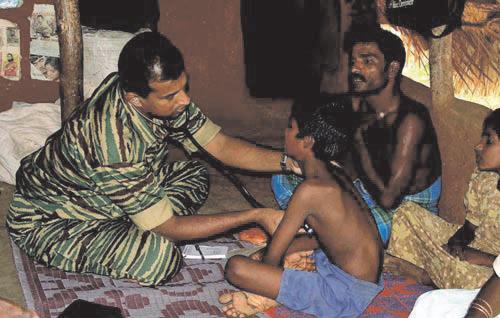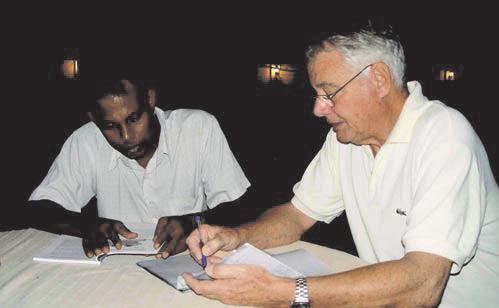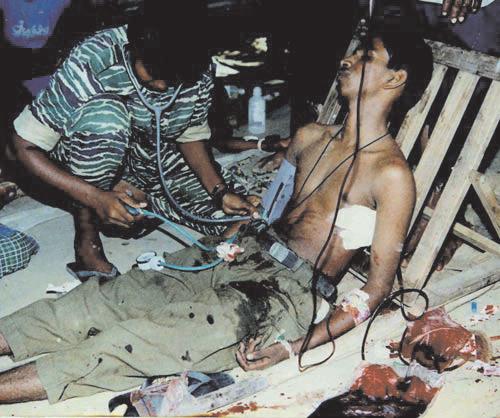|
Tamil Eelam - a De
Facto State
Teaching Tamil Tigers : An Eye Witness Account
John S Whitehall, FRACP, Director of Neonatology
Department of Neonatology, Townsville Hospital, Townsville, QLD.
Correspondence:
[email protected]
20 December 2007
For
over two decades, there has been savage conflict in Sri Lanka between a minority
group of Tamils who claim traditional rights for land in the north-east and the
majority, Sinhalese, government in Colombo. The conflict has consumed tens of
thousands of lives, displaced hundreds of thousands, sown agricultural land with
mines, laid waste plantations, and stunted a generation of children. It could be
argued that the only rule of warfare is the respect each side has for the
capacity of the other to terrorise: the desire for self-preservation has tended
to restrict the number of civilians being bombed. Nevertheless, human rights
organisations have reported over 4000 Tamil deaths in recent months. The conduct
and cost of the conflict is obscured by suppression of the press on the
government side and lack of access of the press to the other.
The
Ceasefire Agreement in 2002 between the leaders for Tamil autonomy, the
Liberation Tigers of Tamil Eelam, and the government in Colombo, and the effects
of the Asian tsunami in 2004 have combined to reduce hostilities and permit
greater access to the north-east by foreigners. In this time of relative peace,
I visited the region in January and again in May 2005, delivering antibiotics
and then ventilators and surgical equipment to hospitals throughout the island,
supplied through the generous response of North Queensland to the tsunami.
Driving
north from Colombo to Jaffna, I was struck by the poverty on the Tamil side of
the armed border, the lack of facilities in the hospital in Kilinochchi (the
administrative centre of the “Tamil” land) and the dilapidation of the tertiary
hospital in Jaffna. Only the crowds in the corridors and the patients on the
floors obscured the filth on the walls and passageways. Nothing obscured the
suffering of apparently half-dead people being carried on bare metal stretchers
at perilous angles up and down the stairs, buffeted in the surge. I was struck
by the whites of their fingers as they clung to the metal. Nothing prevented the
recycling of dengue through unscreened windows from sullage that pooled from
broken pipes alongside the wards. One piddling tap leaned vainly against
cross-infection in the crowded children’s barn. Why was this hospital so
different to the many I had visited in the Sinhalese areas? I later learned of
economic sanctions and underfunding by Colombo.
I
volunteered to return to Sri Lanka in September 2005, originally to work as a
paediatrician on the east coast, but diverted by my hosting organisation to work
in Kilinochchi for a couple of weeks and teach “some students who had missed out
because of the war”. I remembered the needs of Kilinochchi and was willing to
comply. About three weeks later, I discovered that my students comprised the
medical wing of the “terrorist” Tigers!

A
home visit by one of the medical students
I met them in a shed whose walls reached halfway to a roof of corrugated iron
that creaked in the heat of the sun, then roared with the monsoon rains as the
weeks extended to three months, and I swapped tales of sick children for tales
of my students’ lives.
We
began awkwardly. As I entered, there was a sudden scraping of chairs on the
concrete floor and then a silent standing to attention. I was further surprised
by how many there were — 32 — and their being perhaps a decade older than I had
expected. I introduced myself and asked them to sit. There was more scraping of
chairs. Now they were sitting stiffly and silently. “Does anyone speak English?”
I asked, and began to try to work out what they knew and what they needed. I had
no idea I would grow to love them.
I
realised they needed grounding in the old-fashioned approach of taking a
history, examining methodically, and making provisional diagnoses and plans of
management, though I soon sensed they had had profound experiences in triage and
trauma. They had seen a lot of sick children but were thin on theory, so I
decided to prolong my stay and start at the beginning.
After
about two weeks, we had worked our way to the examination of the respiratory
system and it was then that I discovered how close my students had been to the
acute end of medicine. I invited a man to remove his shirt and a woman to
demonstrate her method of examination and was surprised by the divot out of the
man’s shoulder. Asking him what had happened, I noticed a similar deformity in
the woman’s forearm. Shrapnel and a bullet, they explained, and everyone began
to laugh. “Well, who hasn’t been shot?” I asked, and, to my astonishment, only
about a third raised their hands. “Didn’t you notice our wooden legs?” someone
asked and, adding to my foolishness, three were waggled for my inspection, with
the class now in uproar. Who are these people? I wondered, and began the journey
of discovery.
They
comprised the medical wing of the Liberation Tigers of Tamil Eelam and were the
remainder of an original group of over 70 who had been chosen from the ranks of
the infantry because their commanders had concluded they had the potential to
become doctors. The struggle for a Tamil homeland, Tamil Eelam, had entered a
violent phase in the late 1980s, and the problem of casualties had originally
been solved by taking them in small boats to sympathisers in nearby Tamil Nadu,
in India. As the numbers increased and the political situation altered, they
were taken to the hospital in Jaffna. But lives and limbs were lost in
transportation through jungles or around the coast from distant front lines, and
the need for the movement’s own medical wing became obvious. 
Paraphrasing
a student's stories of his experiences
In time, I asked them all why they had
joined the Tigers and learned of the deaths and torturing of family members, of
schools bombed, of the bodies of neighbours washing ashore, of mobs rampaging
against Tamils and of discrimination in education and language. Each one had a
saga and each had joined the Tigers because “they spoke less and did more” to
protect their race against what they were all convinced was genocide. They had
all been trained as infantry, but none had forgotten the speech by their leader,
who had asked them to forego fighting for the greater goal of healing their
people.
The
course had started in 1992, with some students needing preparation in maths,
chemistry and English because they had not finished high school. Others had
graduated in biology from university. The course paralleled the curriculum at
Jaffna University but had been interrupted by long periods of service in field
hospitals, in public health campaigns against cholera and malaria, in the
manning of general hospitals, and by the needs of the tsunami, which had wrecked
the north-east coast. The Ceasefire Agreement of 2002 had allowed them to catch
up on formal education, but they were lacking a module on paediatrics, when I
turned up out of the blue. My 32 students were those who had stayed the course.
Others had been unable to resist the call of the armed struggle, some had failed
academically, and five had been killed on active duty.
It
was obvious they needed tuition that emphasised infectious diseases and
malnutrition and it was easy to gather cases for presentation from my rounds in
the ward and from outpatients. The days began with a lecture or two, then moved
to cases, and included examination of the newborn and resuscitation. The poverty
in the nursery was painful — mothers used old handkerchiefs for nappies.
They
had never performed any formal research and were keen to be divided into groups
to review perinatal outcomes, nutrition, causes for acute admission, snake bites
and emotional effects of the tsunami. We found mothers and children to be wasted
and stunted, road accidents to reflect the dangerous driving through the town,
snake bites to be handled well, and counselling to be effective for grief. The
findings were presented on a special research day, which evolved into an
emotional ceremony of graduation. 
Student
treating civilian wounded by artillery fire
As the weeks progressed, I
learned more of their lives and could not rest until one began to translate
short stories he had written about their experiences. We began to meet every
night in a small gazebo, sometimes curtained with rain, and went over his
stories, line by line, paraphrasing from Tamil and amplifying for a wider
audience in English. My mind was fascinated by the stories of medicine, my
emotions drawn by their humanity.
I
learned of the development of the medical wing from first aid to reconstructive
surgery, encompassing the triage of mass casualties, blood transfusions on the
front lines, and end-to-end anastomoses of arterial wounds with ketamine
anaesthesia by torch light under artillery fire that thudded shrapnel into the
coconut-trunk walls of their bunker. I learned of organisation and secrecy that
could construct a hospital overnight in preparation for a battle in the morning
. . . and of my students who had worked and worked until the casualties stopped
coming — in their uniforms stiff with blood, on legs that could barely stand and
under the sustained threat of sudden death.
I
could scarcely believe accounts reminiscent of the First World War, and insisted
on interviewing all the students mentioned by name, others not mentioned, and
particular patients, cross-checking the details. I went to battlefields to see
if the layout was as described. It was. Though overgrown by jungle, the bunkers
that had contained the operating theatres were still visible, confirmed by
halfburied vials of empty medical containers. Mounds of dirt confirmed former
protective walls, and abandoned paraphernalia confirmed the fighting. Bones and
shredded uniforms confirmed casualties.
Why
they continued to fight still puzzled me, especially as I visited war cemeteries
and pondered the carnage in which over 17 000 Tamil young people have died in
the past two decades. Understanding began on the afternoon of 27 November, their
equivalent of Anzac Day. My students collected me and, for the first time, I
observed them in uniform, making their way through the cemetery, squatting here
and there with parents of the dead who had begun to arrive in droves to festoon
the graves with garlands and food for their young men and women who “were living
on in the spirit of Tamil Eelam”.
There
were about 3000 graves and soon the cemetery was pulsating with grief. The
burning sun sank beneath a row of palms and I anticipated some kind of communal
eruption of emotion as candles were lit on the graves and flickered on distorted
faces. But there was nothing. No hymns, no chants, no catharsis. Just a speech
on the necessity for more sacrifice. Silently, the crowd shuffled away, leaving
the garlands and the candles to the moonless night. I began to realise what some
people are prepared to endure for freedom. 
Students
operating and giving anaesthesia
I had a farewell meal with my students
before I left and before they were dispersed to look after the population of
their Tamil Eelam and the casualties of a war that has escalated. We made
speeches, and they presented me with what was clearly a special gift: a Tiger
flag (which caused anxiety clearing Customs on the way out).
Private
possession of a Tiger flag, I am informed, is not “recklessly supporting a
terrorist organisation”, but detectives from the counterterrorism team of the
Australian Federal Police were keen to explore why I stayed in Kilinochchi when
I learned the identity of the students. I figured teaching doctors how to
resuscitate children was in the interests of the people, whoever controlled
them, but wondered if my career had reached a crossroads!
Subsequently,
I did not mind going over all our overseas phone calls with the police or
explaining why my bank had sent money to England (for a course on radiation
biology), but I was a bit unnerved by the attention I received from immigration
officials when I recently left for New Guinea. Being profoundly Australian, I
found it unsettling to be perceived as being on the “other side”! I hear,
however, that the Department of Public Prosecutions is not proceeding with my
case, which is good news. The bad news is that it is unlikely I will ever be
able to return to Sri Lanka, and the needs of the north-east weigh heavily.
Tamil friends assure me that publicity for the situation is the greatest help I
could offer Sri Lanka. With that in mind, the collection of short stories I
paraphrased will be published in the near future. |